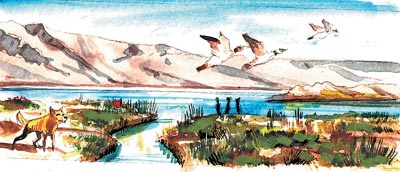Ash Meadows a haven for wildlife

Ash Meadows National Wildlife Refuge in southern Nye County, about 100 miles from Las Vegas, protects desert oasis habitat and unique native creatures and plants. Ash Meadows contains a greater number of endemic species than any other locale in the country, including at least 24 species found nowhere else. Four of its fishes and one plant remain on the federal endangered species list.
A day-use area, it remains open daily year-round, but is best visited during the cooler months of the year. The site draws thousands of visitors annually for wildlife viewing, picnicking, hiking, seasonal hunting and exploring. Reach the area either from U.S. 95, turning south on Highway 373, or by way of Highway 160 through Pahrump, turning on Bel Vista north of town to reach the southern boundary of the refuge. From there, you may choose to follow a main graded refuge road 12 miles north or you may continue to Death Valley Junction and turn north to reach the main entrance, just past the Longstreet Hotel and Casino. Either route takes you to refuge headquarters at Crystal Spring.
Historically exploited for its abundant water, Ash Meadows served variously as producing ranch, bird hunting and fishing preserve, legal brothel, and source of peat from its marshes until 1984. Recognition of the danger of such uses to the rich diversity of life found nowhere else on the planet led to the creation of the refuge, administered by the U.S. Fish and Wildlife Service as part of a complex of four desert refuges.
The Ash Meadows refuge encompasses about 23,000 acres that include springs, streams, seeps and reservoirs of a vast underground water system forced to the surface there by a geological fault. The facility’s main purpose remains protection of the fish and other creatures and plants naturally found there. To ensure their survival, long-term work includes returning the oasis setting to pre-ranching wetlands and marshes, and eradication of introduced plants and animals.
Headquarters at Crystal Spring includes a ranger station, picnic area, informational kiosk and restrooms. A boardwalk trail runs a few hundred yards to beautiful Crystal Spring with spur walkways accessing viewing areas along the little stream fed by the warm water spring.
Here visitors get their first glimpse of one of the unique populations of pupfish found only in various springs on the refuge. At this time of year the little fish are a silvery gray-green with vertical stripes. During the summer mating season, the males turn a blue rivaling the pure color of their spring.
Some visitors prefer viewing the pupfish at Point of Rocks a couple of miles south of Crystal Spring. Take a look at nearby King Spring, where habitat restoration continuing throughout the refuge is finished. Found only at neighboring Devil’s Hole, part of Death Valley National Park, a fluctuating population of fish live upon a ledge above a deep subterranean cavern.
Crystal Spring feeds a small lake that draws many waterfowl and wading birds such as egrets and herons. Bald eagles frequent the area, perching atop the larger trees while spotting meals of fish, birds and small animals. Popular with birdwatchers, the area attracts many of the 239 kinds of birds living on the refuge or seasonally visiting. Ask at the ranger station for a list of known birds. The site serves as a good station during the upcoming December bird count.
Since the refuge closes at dusk, visitors wanting to stay overnight should check out hotel rooms and RV sites elsewhere. The Longstreet, Death Valley Junction, Death Valley National Park and nearby towns offer options.
Margo Bartlett Pesek’s column appears on Sundays.